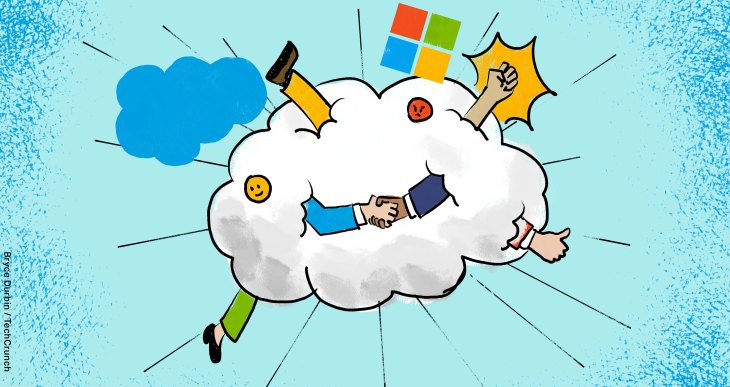When Salesforce announced this week that it was moving Marketing Cloud to Microsoft Azure, it was easy to see this as another case of wacky enterprise partnerships. But there had to be sound business reasons why the partnership came together, rather than going with AWS or Google Cloud Platform, both of which are also Salesforce partners in other contexts.
If you ask Salesforce, it says it was ultimately because of compatibility with Microsoft SQL.
“Salesforce chose Azure because it is a trusted platform with a global footprint, multi-layered security approach, robust disaster recovery strategy with auto failover, automatic updates and more,” a Salesforce spokesperson told TechCrunch. “Marketing Cloud also has a long standing relationship with Microsoft SQL which makes the transition to SQL on Azure a natural decision.”
Except for the SQL part, Microsoft’s chief rivals at AWS and Google Cloud Platform also provide those benefits. In fact, each of those reasons cited by the spokesperson — with the exception of SQL — are all part of the general cloud infrastructure value proposition that all the major cloud vendors provide.
There’s probably more to it than simply compatibility. There is also a long-standing rivalry between the two companies, and why in spite of their competition, they continue to make deals like this in the spirit of co-opetition. We spoke to a few industry experts to get their take on the deal to find out why these two seeming rivals decided to come together.
Retailer’s dilemma
Tony Byrne, founder and principal analyst at Real Story Group, thinks it could be related to the fact it’s a marketing tool and some customers may be wary about hosting their businesses on AWS while competing with Amazon on the retail side. This is a common argument for why retail customers in particular are more likely to go with Microsoft or Google over AWS.
“Salesforce Marketing Cloud tends to target B2C enterprises, so the choice of Azure makes sense in one context where some B2C firms are wary of Amazon for competitive reasons. But I’d also imagine there’s more to the decision than that,” Byrne said.
Byrne also says there is probably a more practical reason: the company simply needed to move Marketing Cloud somewhere because it was running on older technology, needed to modernize and Azure made the most sense in this instance.
“Marketing Cloud never ran on the Force.com platform. The former ExactTarget team and infrastructure was always very independent and had their own hosting infrastructure. This was not sustainable and they had to make a move to the cloud,” he said.
Marketing Cloud actually came together from several acquisitions including ExactTarget, Buddy Media, Radian6 and others over the years.
Holger Meuller, an analyst at Constellation Research, says that it might not be that strange, given that most SaaS vendors including Salesforce have a presence with a variety of cloud vendors. “They want to put their eggs in different baskets. It’s smart. It’s the same approach SAP [and others] took,” Meuller said.
Strange bedfellows
As Microsoft and Salesforce come together for this deal, it’s another case of companies putting aside competitive rivalries to do what’s best for their organizations and presumably, their customers. Microsoft and Salesforce compete on several levels with their CRM and marketing products, but Salesforce is still willing to host a key product family there, while Microsoft is willing to place a competing product on its platform because it makes business sense. Salesforce is the gold standard of pure SaaS vendors and having a piece of its business is good for business.
You probably wouldn’t have seen this with the big stack vendors in the 1990s and early 2000s, but it was a different world back then. In those days, companies like Oracle and Microsoft wanted to control the entire stack from server to software and everything in between. They wanted to lock you into their solutions and make it as difficult as possible for anyone competing to make any headway at any point in the stack.
The cloud changed all of that because companies (and even individual users) had more control over product choices, and the subscription model is much more flexible than the old license approach. That allows companies to move from one vendor to another much more easily (at least in theory).
In light of this, companies have to look at markets and the competitive landscape differently. Sure, they are going to compete (and probably gloat when they win big deals), but in the end if it makes sense to work together, they are going to do it.
Paul Greenberg, author of CRM at the Speed of Light and principal at The 56 Group, LLC., says that since Satya Nadella took over as CEO in 2014, there has been a concerted push by Microsoft to become the vendor of choice of big SaaS companies, and there is nobody bigger than Salesforce in SaaS.
“If Microsoft is to succeed at accomplishing that vision, they have to get past that competitive mindset that has dominated the enterprise tech world and go more toward co-opetition. And they have been doing that remarkably well,” Greenberg said.
Lots of factors go into choosing a cloud vendor. Whatever the reasons, Salesforce is moving Marketing Cloud to Azure and the two companies continue to find ways to work together in spite of their competitive differences.
